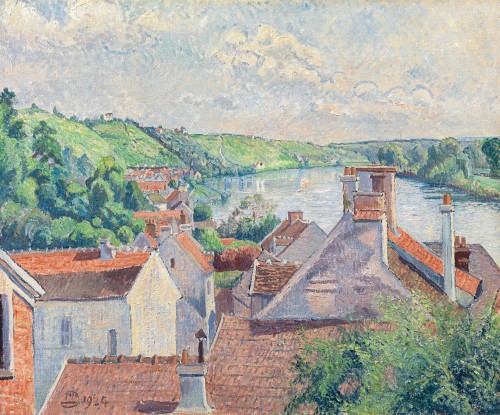LUCIEN PISSARRO
Paris 1863 - 1944 Hewood, Somerset
Ref: CC 117
Vue de la Frette, sun
Signed with monogram and dated lower left: LP 1924
Oil on canvas: 21 ¼ x 25 ⅝ in / 54 x 65.1 cm
Frame size: 27 x 32 in / 68.6 x 81.3 cm
In a Louis XIV style gilded composition frame
Painted in June 1924
Provenance:
Private collection, UK;
by descent in a private collection, UK;
Handsworth Methodist Training College, acquired from the above;
Queen’s College, Birmingham, acquired from the above;
private collection, UK, acquired from the above in 1971;
by descent in July 2000 to a private collector, UK
Exhibited:
London, The Leicester Galleries, Lucien Pissarro, 1924, p.19, no.81
Birmingham, Ruskin Gallery, Lucien Pissarro, 1928, no.7
Literature:
Anne Thorold, A Catalogue of the Oil Paintings of Lucien Pissarro, London 1983, pp.172-3; no.381, illus.
The eldest son and pupil of Camille Pissarro (1830-1903), Lucien Pissarro grew up with the Impressionists but, like his father, was influenced by the Post-Impressionism of Georges Seurat and Paul Signac. In 1890 he moved permanently to England, marrying an English artist, Esther Bensusan. Lucien made frequent trips back to France, maintaining contact with the large, creative and close Pissarro family. He was an important conduit for artistic theories between Britain and France.
Lucien remained true to his father’s concern with the observation of nature in all its moods and his habit of painting en plein air. He declared in 1925: ‘I am aiming at the study of light’[1]. However, by 1924, when Vue de La Frette, sun was made, his landscapes reflect aspects of Modernism while remaining linked to his artistic heritage. The crisp geometry of the roofs of La Frette and the subtle lines which delineate the distant countryside find echoes (albeit more radical) in the Post-Impressionism of Albert Marquet, who also painted in La Frette in this period.
The village of La Frette-sur-Seine, known as ‘la Perle du Val d’Oise’, lies about twelve miles north-west of Paris, easily reached by the railway lines that fanned out from the capital from the nineteenth century. Apart from Marquet, its picturesque setting attracted Paul Cézanne and Paul Signac, among many other artists. Lucien travelled to the Pissarro family home at Eragny early in 1924 and then moved on to La Frette, staying there at 5 Rue de la Vallée from 9th April to 24th November. He wrote to his daughter Orovida from Paris on 2nd April: ‘Well the hen has found the nest but the eggs are still to come – the nest is to be at La Frette, a village not far from Paris – 20 minutes on the Pontoise line – a charming place with hills covered with lilacs, cultivate [sic] for Paris flower market – presently it is going to be a wonderful site – the river banks are also charming – the village is like all the same village full of quaint peasant houses and (alas!) diapered with ‘nougat’ villas – but on the whole very paintable’[2].
This view is taken from the slopes of the right bank of the Seine, looking westwards. The thirteenth century church of Saint Nicolas can be seen nestled at the bend of the river in the left middle distance. Lucien plays with the interlocking complexities of the mellow tiled roofs of the village, which stretch along the river. Sunlight bathes the scene. He brings out the subtle colours of the sun-warmed plaster of the house at foreground left, blending a myriad of short, staccato brushstrokes in tones of pale pink, palest lilac and cream. The geometry of the buildings is softened by the brilliant green of the tree in the right foreground and by the cascade of trees which tumbles down the hillside to envelop La Frette. As in the work of Camille Pissarro, Lucien’s composition emphasises both the human connectivity of the ancient houses and nature’s enfolding presence, swathing the warm orange tones of the dwellings in joyous green summer foliage. The painting was made in June 1924. Lucien worked slowly and painstakingly en plein air, setting aside each canvas as the light conditions changed. He wrote to his wife Esther on 19th June: ‘I have finished at last my two sunny pictures’[3]. The atmospheric Vue de La Frette, sun amply demonstrates his philosophy of painting: ‘what must be rendered is not the object, but the expression of the feelings caused by the object’[4].
Several works from Lucien Pissarro’s 1924 painting campaign in La Frette are in museum collections, including Un coin du village, La Frette (University of Hull Art Collection); La Frette (Bristol Museum and Art Gallery) and La Frette and Sartrouville (National Gallery of Melbourne, Victoria).
[1] Letter to Orovida Pissarro, 19th May 1925 (Pissarro Family Archive, Ashmolean Museum, Oxford). Quoted in Thorold, op. cit., p.23.
[2] Pissarro Family Archive, Ashmolean Museum, Oxford; quoted in Thorold, ibid., pp.22-23.
[3] Pissarro Family Archive; quoted in Thorold, ibid., p.172.
[4] Translation of letter from Lucien Pissarro on 10th April 1942 to his nephew by marriage, John Bensusan-Butt; quoted in Thorold, ibid., p.xvi.






















